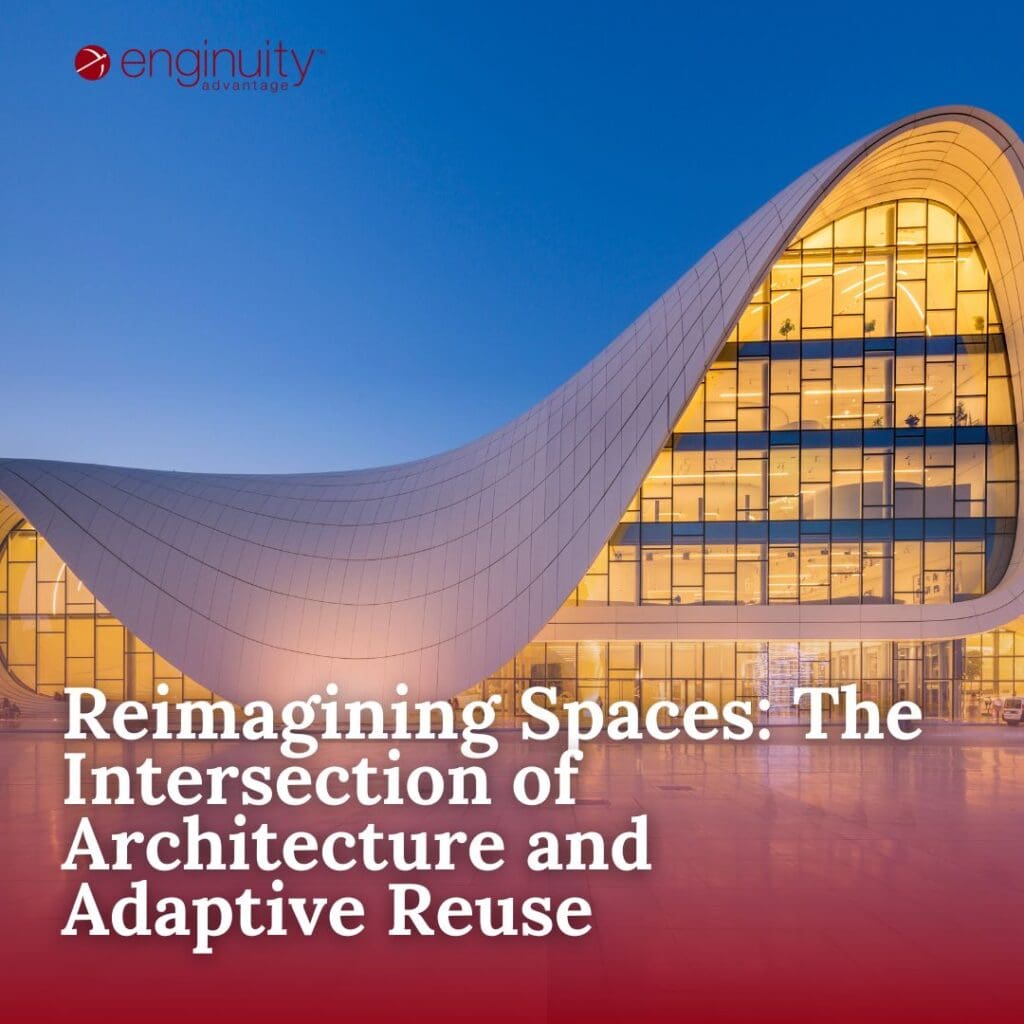The Intersection of Architecture and Adaptive Reuse

We’ve all had those strolls through the city, gazing at aged, forgotten buildings, their bricks and beams laden with memories, and pondered their potential. Can that century-old warehouse turn into an art studio? Could that derelict schoolhouse morph into a hipster café? These aren’t mere musings; they’re the seeds of adaptive reuse. A concept where we embrace the romance of the old while infusing the vibrancy of the new. As we stand at a pivotal juncture, with urban spaces bursting at the seams and the looming environmental crisis, adaptive reuse isn’t just a chic architectural approach; it’s a call to action. With a whopping 68% of humanity projected to reside in cities by 2050, the challenge and opportunity of reimagining spaces have never been this pressing or exhilarating.
Dusting Off the Cobwebs and Seeing Potential
The art of seeing beyond the surface rust and wear is a skill that’s gold in the architecture world. Every faded mural or crumbling brick has a story that’s waiting to be retold, and the magic lies in merging the past with the present. Now, let’s sprinkle in some numbers to truly grasp the scope: a jaw-dropping 500 million square feet of buildings become obsolete every year, it can be more than 330 million by the end of the decade. Rather than viewing these as relics of yesteryears, consider them canvases primed for reinvention.
When you dig deeper into the layers of dust and history, there’s an underlying framework—robust bones, if you will—that can be the foundation for new visions. The architectural trends of the past often provide spaces that can be reimagined in fresh, innovative ways. Think grandiose ballrooms morphing into co-working spaces or old fire stations becoming boutique hotels. The key is to maintain a balance, cherishing the aesthetic essence and historic significance of these structures while retrofitting them with modern amenities and functionality.
Additionally, it’s not just about tangible transformation; it’s a mindset shift. Adaptive reuse encourages architects to embrace a sustainable mindset. The EPA estimates that between 230 and 530 million tons of construction and demolition debris are produced nationwide each year in the United States. Reimagining spaces reduces waste, conserves resources, and breathes life back into neighborhoods, often igniting community revitalization.
In essence, by dusting off those cobwebs and seeing beyond the immediate wear and tear, architects hold the power to not only reshape a building but redefine the narrative of entire communities. So, next time you walk by that old, seemingly forgotten structure, don’t just see decay; envision opportunity.
Green Bonus Points
With climate change increasingly at the forefront of global conversations, the architectural world isn’t exempt from the pressure to go green. And guess what? Adaptive reuse is arguably one of the most eco-friendly practices in the field. Let’s crunch some numbers: The construction industry alone is responsible for a whopping 40% of global carbon emissions. That’s right, almost half. By repurposing existing structures, we significantly reduce the carbon footprint linked to demolishing old edifices and erecting new ones from scratch.
But there’s more to it than just the carbon savings. Repurposing materials inherently means less waste heading to our already overburdened landfills. By giving those old bricks, beams, and tiles a second life, we’re directly contributing to a decline in that figure.
Beyond the tangible materials, there’s also the energy factor. Older buildings were often constructed with high-quality materials and techniques that inherently have strong insulative properties. By retaining these features, we can leverage their natural energy efficiencies, further conserving resources and cutting down on heating and cooling costs.
Furthermore, championing adaptive reuse isn’t just an environmentally-conscious move; it’s also a strategic one. With the rise of the eco-conscious consumer, 73% of millennials, the largest chunk of the current workforce, are willing to pay more for sustainable offerings. By diving deep into adaptive reuse projects, architects and firms can showcase their commitment to sustainability, positioning themselves more attractively in a competitive marketplace.
Every repurposed beam or salvaged tile isn’t just a nod to the past; it’s a big green thumbs-up for our planet’s future. Embracing adaptive reuse means racking up those green bonus points, both environmentally and in the eyes of clients and communities. It’s a win-win, really!
Culture Vulture
In an age where skyscrapers seem to be popping up on every corner and newfangled structures dominate city skylines, there’s an undeniable charm and gravitas that only historic buildings can offer. These structures are more than just brick and mortar; they’re tangible timestamps of our shared history, telling tales of times gone by.
Firstly, it’s crucial to note that every old building has its own unique story. Whether it’s a once-bustling factory from the Industrial Revolution or a quaint cottage that has witnessed centuries, each comes with a rich tapestry of events and emotions. By embracing adaptive reuse, architects essentially become storytellers, ensuring that these narratives aren’t lost to the annals of time.
The charm of old towns, the allure of historical districts, the tales these walls whisper – all contribute significantly to the cultural fabric of a community.
There’s an undeniable economic angle to it. Historical districts or buildings often act as significant tourist magnets. Just think about the bustling lanes of old European towns or the heritage quarters in bustling Asian cities. They not only draw in tourists but also contribute to local businesses, from cafes to antique shops.
Engaging with adaptive reuse also showcases an architect’s prowess in marrying the old with the new. It’s one thing to design on a blank canvas and quite another to reimagine a space while respecting its historical context. This not only broadens an architect’s skill set but also garners respect from peers and clients alike.
In the grand scheme of things, it’s not just about retaining a building; it’s about preserving the collective memories, stories, and essence of an era. For architects, diving into adaptive reuse isn’t merely a project; it’s an opportunity to be the custodians of culture, ensuring that the future always has a bridge to the past.
Nitty-Gritty Tips for Job Seekers
Stepping into the world of architecture, especially in the adaptive reuse niche, can be both exhilarating and daunting. But fear not, young padawan; the world of design and creation is vast, and with the right approach, you can carve out a successful path for yourself. Here’s the low-down for all you job seekers to make your mark in this dynamic arena:
- Be a History Buff: Before you even think about repurposing an old building, you need to understand its past. Delve deep into its history, not just from a construction viewpoint but from a cultural and societal one.
- Portfolio Power: When crafting your portfolio, try including any projects, even academic ones, where you’ve repurposed or reimagined an existing structure. This not only showcases your technical skills but also demonstrates your ability to think out of the box.
- Networking Nuances: Attend workshops, webinars, and conferences focused on adaptive reuse. Engage with professionals who are making waves in this field.
- Sustainability is Sexy: Green architecture and adaptive reuse go hand in hand. Enhance your knowledge on sustainable practices, green certifications, and eco-friendly materials.
- Tech-Savvy Time: Embrace new architectural software and tools. From 3D visualization tools that can help visualize adaptive reuse possibilities to AR and VR for immersive walkthroughs, being technologically adept is a massive advantage.
- Stay Updated: Architecture, like any field, is ever-evolving. Dedicate time to read journals, articles, and blogs. Knowledge about current trends and challenges in adaptive reuse can give you an edge during interviews.
- Soft Skills Shine: Communication is crucial. You might have a groundbreaking idea, but if you can’t present it effectively to clients or stakeholders, it’s of no use.
- Mentor Magic: Seek out professionals who’ve been in the adaptive reuse game for a while. Their insights, feedback, and guidance can be invaluable. Plus, having a mentor gives you a peek into the real-world challenges and solutions of the domain.
Now, while all this information might be a tad overwhelming, remember you don’t have to navigate these waters alone. Our seasoned team has a deep well of experience, resources, and insights tailored for you. We understand the unique challenges and opportunities in this niche of architecture, and we’re here to guide, mentor, and equip you for success.
Your dream job awaits, and we’re thrilled to help pave the way. Let’s bring the past into the present, together!
Unlock Dream Careers & Elite Talent: Just One Click Away!


